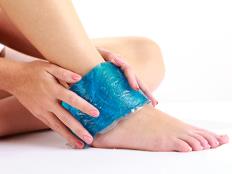7. Stress Fracture
Unlike an acute fracture that happens as the result of a slip or fall, stress fractures develop as a result of cumulative strain on the bone. Runners most often have stress fractures in their tibias (shin), metatarsals (feet), or calcaneus (heels). They are one of the most serious of all running injuries; almost six percent of poll respondents had one in the past year.
WHO'S AT RISK?
Runners who overtrain. Bones need downtime to rebuild after a workout. If you increase the duration, intensity, or frequency of your running too soon, your bones can't repair themselves fast enough to keep up. Stress fractures are more common in women than men, usually due to nutritional deficits, low estrogen levels, and inadequate calorie intake. Luckily, weight-bearing exercise like running is protective, which means experience is on your side. "The longer you've been running, the lower your risk is," Dr. Price says.
CAN YOU RUN THROUGH IT?
In a word: no. Expect to take eight to 16 weeks off from running. The amount of rest you'll need depends on the severity of the fracture and its location. Weight-bearing bones like those in the foot heal slower than those in the shin, for example. And if you ran through the pain for a while before you realized you had a fracture, your recovery could take longer, Merrill says. Avoid all impact exercise. Instead, pool-run and swim.
REHAB IT
Listen—well—to your body.
"Once you can walk without any pain, you can try a bit of jogging," Dr. Price says. "But you have to back off if there is lingering pain. It's crucial that you build your mileage slowly—start with just a few minutes."
PREVENT A RELAPSE
Improve bone density with weight training, and make sure you're getting enough calories and nutrients. Contrary to popular belief, running surfaces don't seem to make a difference.
"It makes sense that running on soft surfaces like grass would be better than roads, but studies have not borne that out," Price says.
ELITE TREATMENT
Some people with stress fractures can maintain fitness with pool running.
"When Deena Kastor suffered a broken bone in her foot during the 2008 Olympic Marathon, she had to take six weeks off," Price says. "Daily pool running kept her strong."
After making a recovery, she ran a 2:28 Chicago Marathon in 2009.
Bone Scan: How to Proceed
If pain continues to build as you run—but it doesn't just hurt when you run. Even just being on your feet is uncomfortable.
Sorry, there's no middle ground here. With this injury, you are either in the red and should be shut down, or in the green zone and good to go.
When you're pain-free throughout a run with absolutely no lingering pain afterward—even when you've been on your feet all day.
Connect with us on Twitter, Facebook, Instagram or Pinterest for more tips, recipes and ideas to fuel your ACTIVE life.
 Find your next race.
Find your next race.
- 8
- of
- 8
Get ACTIVE on the Go


Couch to 5K®
The best way to get new runners off the couch and across the finish line of their first 5K.
Available for iOS | Android







Discuss This Article